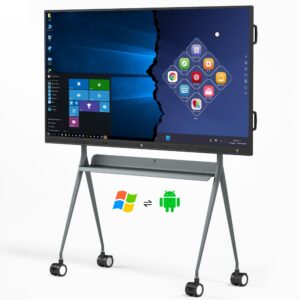All-in-One Interactive Panel, also known as an Interactive Flat Panel Display (IFPD) or Interactive Touchscreen Display, is a sophisticated piece of technology that combines a high-resolution display panel with touch and interactive capabilities in a single unit. These panels are designed for a wide range of applications and are particularly popular in educational, corporate, and collaborative settings. Let’s explore what an All-in-One Interactive Panel is, why it is used, and where it finds applications:

What is an All-in-One Interactive Panel?
An All-in-One Interactive Panel is a large-format touchscreen display that typically features the following components:
- High-Resolution Display: The panel boasts a high-quality LED or LCD display with excellent resolution and brightness, ensuring clear and vibrant visuals.
- Touchscreen Technology: It incorporates capacitive or infrared touchscreen technology that allows users to interact directly with the screen using their fingers or a stylus.
- Interactive Software: The panel often comes with pre-installed or downloadable interactive software that enables a wide range of functions, such as drawing, writing, annotating, and collaborative work.
- Connectivity Options: These panels offer various connectivity options, including HDMI, USB, Wi-Fi, and Bluetooth, making it easy to connect to other devices, such as computers, tablets, and smartphones.
- Built-in Audio and Speakers: Many All-in-One Interactive Panels have built-in speakers and audio capabilities for multimedia presentations and video conferencing.
Why Use an All-in-One Interactive Panel?
- Enhanced Engagement: Interactive panels make content more engaging and interactive, which is especially valuable in educational settings to keep students engaged and in corporate environments for interactive presentations.
- Collaboration: They facilitate collaborative work, allowing multiple users to interact with the content simultaneously, which is beneficial for brainstorming, group discussions, and teamwork.
- Versatility: These panels are versatile and can be used for various purposes, including presentations, interactive lessons, video conferencing, digital whiteboarding, and more.
- Ease of Use: They are user-friendly and intuitive, making them accessible to people of all ages and technical backgrounds.
- Visual Impact: The high-resolution displays and touch capabilities offer a visually stunning and memorable experience, making them ideal for presentations and demonstrations.
Where Are All-in-One Interactive Panels Used?
- Education: All-in-One Interactive Panels are widely used in classrooms and educational institutions. They enhance the learning experience by allowing teachers to create interactive lessons, conduct digital quizzes, and encourage student participation.
- Corporate: In the business world, these panels are used in meeting rooms, boardrooms, and conference spaces for interactive presentations, video conferencing, and collaborative discussions.
- Training: Companies use interactive panels for employee training and workshops to make training materials more engaging and interactive.
- Healthcare: Hospitals and medical facilities utilize these panels for interactive patient education, medical training, and telemedicine applications.
- Retail: Retailers use interactive panels for product demonstrations, virtual shopping experiences, and customer engagement.
- Entertainment: In entertainment venues, such as museums and theme parks, these panels offer interactive exhibits and displays to engage visitors.
- Public Spaces: In public spaces like airports and malls, interactive panels provide wayfinding information, directories, and interactive advertising.
- Government: Government agencies use interactive panels for public information displays, interactive maps, and educational exhibits.
- Hospitality: Hotels and resorts use interactive panels in guest rooms to provide information about services, amenities, and local attractions. They can also be used for in-room dining orders and entertainment options.
- Manufacturing and Engineering: In manufacturing facilities and engineering environments, interactive panels are used for process control, equipment monitoring, and interactive training programs for employees.
- Libraries: Libraries incorporate interactive panels for interactive catalog searches, digital storytelling, and educational programs for library patrons, especially children.
- Exhibitions and Trade Shows: Companies and organizations use interactive panels at exhibitions and trade shows to engage attendees with interactive product demonstrations, virtual tours, and informational kiosks.
- Worship Spaces: Places of worship utilize interactive panels for scripture display, hymn lyrics, and interactive presentations during religious services and events.
- Gaming and Entertainment: Interactive panels are integrated into gaming consoles, entertainment centers, and virtual reality systems to provide immersive gaming and entertainment experiences.
- Science and Research: Research institutions and laboratories may employ interactive panels for data visualization, interactive data analysis, and scientific presentations.
- Home Automation: In smart homes, interactive panels act as control hubs for various smart devices, allowing homeowners to manage lighting, security, climate, and entertainment systems.
- Art and Design: Artists and designers use interactive panels for digital art creation, design presentations, and interactive installations that combine technology and creativity.
- Language Learning: Interactive language labs and language learning centers utilize these panels to engage students in language learning exercises, pronunciation practice, and interactive lessons.
- Accessibility: All-in-One Interactive Panels can be equipped with accessibility features, making them useful for individuals with disabilities, such as screen readers and magnification tools.
- Sports Coaching: Coaches and trainers use interactive panels for analyzing game footage, illustrating strategies, and conducting team meetings.
All-in-One Interactive Panels are becoming more powerful and feature-rich, offering even more possibilities for interactive communication and engagement across various industries. Their adaptability to different settings and purposes continues to make them valuable tools for enhancing education, collaboration, communication, and customer engagement. Whether in classrooms, boardrooms, healthcare facilities, or public spaces, these panels are transforming the way we interact with information and technology.
All-in-One Interactive Panels have become essential tools for communication, education, collaboration, and engagement in a wide range of industries and settings. Their versatility, ease of use, and ability to make content interactive make them valuable assets in today’s digital world.
